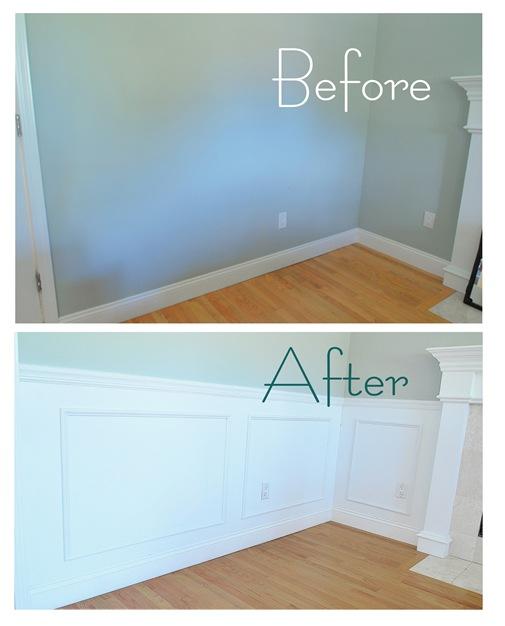wainscoting Panels is one of my favorite feature in a house’s architecture.
Never rule off wainscoting as an option because it’s too expensive, too difficult, or impossible to build on, whether you’re building a new house or looking to buy an existing one.
Conversely, it’s among the cheapest and simplest do-it-yourself improvements you may take on.
This post is for you if you adore the style of wainscoting panels but can’t afford the price.
You can create a look you’ll enjoy until you’re ready for the real thing using inexpensive materials.
A much-needed makeover was given to this laundry area by the wainscoting panels wall.
Over the past two years, this little laundry room/mudroom has undergone some upgrades.
I finished my bathroom room for $100, so I thought it was time to take care of the wall that had been housing my kids’ jackets and back packs for a long time.
My kids can keep their college backpacks in their bedrooms now that they are adults.
We placed a lot of useless stuff on the hooks as they served as a catch-all.
I was in such a hurry to get it cleaned up that I forgot to take a photo of the madness!
However here’s a photo of the wall after I removed the hooks and before I created the faux wainscoting panels.
A little blurry, but it’s the only one I took
Whether you want to protect walls in high-traffic areas of your home or just add visual interest to a bare plane, paneling and wainscoting are easy solutions.
It’s helpful to get familiar with some terminology so you can select the right option to fit your needs and aesthetic.
In this post, we’ll define paneling and wainscoting, explain the differences between the two, and discuss why you’d use one over the other.
Before & After

Wainscoting vs. Paneling?
Wainscoting is essentially a kind of ornamental paneling.
While paneling can be installed on the ceiling or from floor to ceiling, wainscoting is usually restricted to the lower third or half of a wall.
In order to set wainscoting apart from the wall, it usually has some kind of molding at the top.
In addition to typical wood, other materials that may be used for wainscoting and paneling include PVC, medium-density fiberboard (MDF), ceramic tile, embossed metal, and molded materials.
Paneling
The term “paneling” may instantly conjure images of the antiquated plywood paneling that was common in many American homes throughout the 1960s and 1970s.
Different forms of paneling have been popular for decades, even if this specific kind has long gone out of style.
Paneling’s enduring appeal comes from the protection and extra durability it offers walls as well as how quickly and drastically it may alter a room’s appearance.
Types Of Paneling
Traditional wood veneers as well as unique woods like mahogany, teak, ebony, and zebrawood are used in paneling today.
Panel sizes range from 4 x 8 to 2 x 4, based on the desired aesthetic.
Any space gains a sense of formality with raised or beveled panels, which give the impression of being three-dimensional.
Panels may be put either vertically or horizontally for a more fashionable appearance.
One of the most well-liked styles of horizontal paneling for interior spaces nowadays is shiplap.
Other arrangements, including herringbone or diagonal patterns, can also be achieved using paneling, especially if planks are used in place of bigger panels. The paneling pieces do not need to line up perfectly.
Spaces between panels are a hallmark of several modern installation techniques.
Another paneling style that’s hot right now for modern homes is reclaimed wood.
This kind of panel looks worn in and lived in, making it ideal for an accent wall.
We haven’t yet covered other well-liked paneling designs, such as board-and-batten, tongue-and-groove, flat paneling, and beadboard.
Not every paneling is made of real or fake wood. Faux stone, brick, rock, and even cloth are also used in today’s fashions.
Wainscoting
Since the phrase “wainscot” first appeared hundreds of years ago, it has been used to describe wall protection and insulation. These days, the term “wainscoting” typically refers to interior wall paneling that extends just to the lower half of the wall.
As a stylistic feature, wainscot has an ageless appeal and is a great way to give your interior space more visual character.
Think about entryways, hallways, kitchen and dining areas where hands, shoulders and chairs may rub against the wall, causing your paint or wallpaper to get damaged. Wainscoting can add a layer of protection as well as decoration.
If your wall is already damaged, it can be used to cover up blemishes.
In any area of the house, strategic wainscoting panels can break up the look of plain walls, and add visual interest to a room.
Types Of Wainscoting
Wainscoting may be made with several of the paneling kinds that were previously discussed.
There are a plethora of alternatives available, spanning from classic designs to contemporary farmhouse shiplap.
The panels might be extremely basic or carved with designs.
Simple chair rails or ornate paneling with carved molding at eye level are two examples of wainscoting panels.
You may discover alternatives with straight or beveled edges in every color you can imagine.
To provide even more visual intrigue, you may even mix different varieties.
Wainscoting often falls into the following categories: tongue-and-groove, chair rails, shiplap, beadboard, and “chairs and squares.”
What then is the material for wainscoting? Stone, brick, and rock textures can be included into wainscoting in addition to wood and imitation wood materials.
Although wall paneling or wainscoting is usually associated with interior design, it may also be applied externally on your house.
Pros And Cons Of wainscoting panels
Both wainscoting and paneling offer insulation against temperature and noise pollution, protection against damage and the ability to cover blemishes.
They are also easier to repair than drywall, and allow you to easily change the look of a room without extensive construction.
There are cons though.
If you’re using real wood, the panels that are frequently exposed to humidity and moisture can rot if not properly sealed.
If poorly installed, they can shrink and split, leaving unwanted spaces.
Fluctuating temperatures can cause warping and bulging.
Prices on paneling and wainscoting can range from very affordable to exorbitant.
Careful research before purchasing and installation will help make sure you don’t break the bank before the job is done.
Which To Use?
In the end, whether you choose paneling or wainscoting will depend on the aesthetic you want to accomplish.
It is important to match the panel or wainscot style in your home to the design you desire.
A home with a clean, contemporary interior design will not look good with intricately carved, ornamental wainscoting. Wainscoting is the material of choice if you wish to divide a wall along its length.
Paneling is the way to go if you want to completely change a wall.
This also holds true for outside possibilities.
For many homes, paneling works well, particularly if you want a single, unbroken line from the roof to the ground.
Wainscoting is the greatest option if you want to add rock or brick to an outside wall without covering the entire wall with these materials.
Knowing the distinctions between these décor pieces can help you choose the one that’s best for you.
More Ideas on see video
